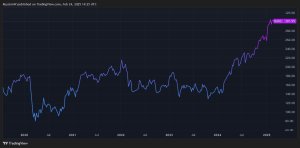Nvidia (NASDAQ: NVDA) stock fell 6.6% yesterday (17 July). Over one month, it’s down 13% from both its 52-week and split-adjusted record high of $135.
Mind you, it’s still up 2,700% in five years! That’s the type of return to make rival chipmakers green with envy. Perhaps that’s not surprising, given the name Nvidia is derived from the Latin word invidia, which translates to ‘jealousy’. Hence the green eye on the company’s logo.
Anyway, while this pullback hasn’t really dented the long-term return, there are some issues I think Nvidia investors should consider.
When the chips are down
Yesterday, the whole semiconductor sector took an almighty tumble. Two stocks in my own portfolio — ASML and Taiwan Semiconductor Manufacturing (TSMC) — plunged 11% and 9%, respectively.
This followed two pieces of news. Firstly, the Biden administration is considering more stringent rules on exporting chips and related equipment to China. It could even invoke a rule that prevents foreign-made products with even the slightest bit of US technology from being sold to Chinese customers.
Meanwhile, Donald Trump dropped some incendiary rhetoric about Taiwan. He claimed the island nation took “about 100%” of the American chip business and that “Taiwan should pay us for defense“.
This has raised fears that a Trump administration would be unwilling to defend Taiwan’s independence in the event of an invasion by China. The Nationalists in China retreated to Taiwan in 1949 after being defeated by the Communists in the Chinese Civil War. Beijing still claims sovereignty over the island.
What this means for Nvidia
Nvidia is a ‘fabless’ chipmaker, which means it doesn’t manufacture its graphics processing units (GPUs) in its own fabrication plants (fabs). Instead, it outsources this to others, notably TSMC, for its higher-end H100 GPUs. These are the chips at the forefront of the artificial intelligence (AI) revolution.
According to the US International Trade Commission, about 92% of the world’s most advanced chipmaking capacity is in Taiwan. So the threat of an invasion is a massive risk — for the AI revolution, Nvidia’s business, the whole stock market, and the world at large.
Regarding export restrictions, Nvidia is already banned from selling its most advanced chips to China. It has worked hard to produce workarounds (modified chips) to keep sales growing there. But I think investors should brace themselves for the potential loss of a lot of China sales in the years ahead.
Some numbers
So, how much would that be? Well, in its last financial year (which ended in January), the company made $10.3bn in revenue from its China business. Or nearly 17% of annual revenue.
This year, the firm is expected to generate more revenue from China despite the restrictions. That could be about 10% of total sales. So this would be a sizeable chunk of the business to lose.
What next?
Meanwhile, its US customers are concentrated among a handful of giant tech companies. So there is customer concentration risk here, magnified by the fact that most of these firms are designing their own chips to reduce reliance on Nvidia.
I wouldn’t be surprised to see the stock bounce back quickly. But it’s trading at 43 times forward earnings and looks priced for perfection. As things stand, I think there are cheaper and safer AI stocks to consider.
This post was originally published on Motley Fool







